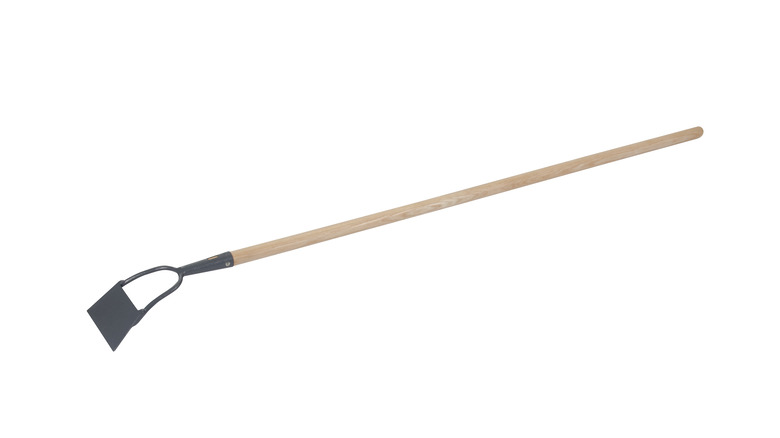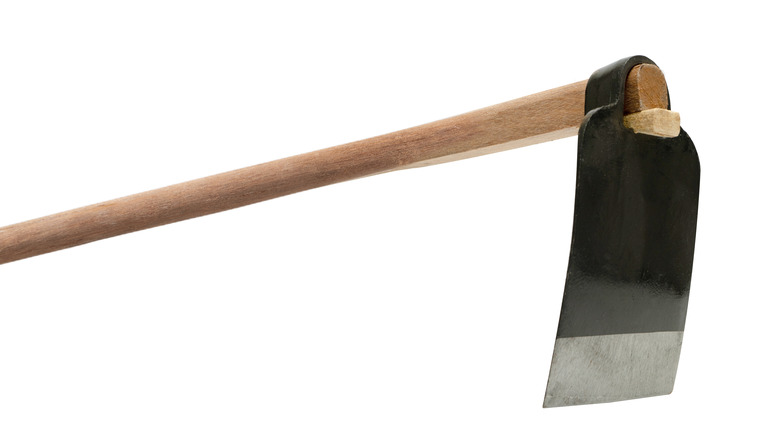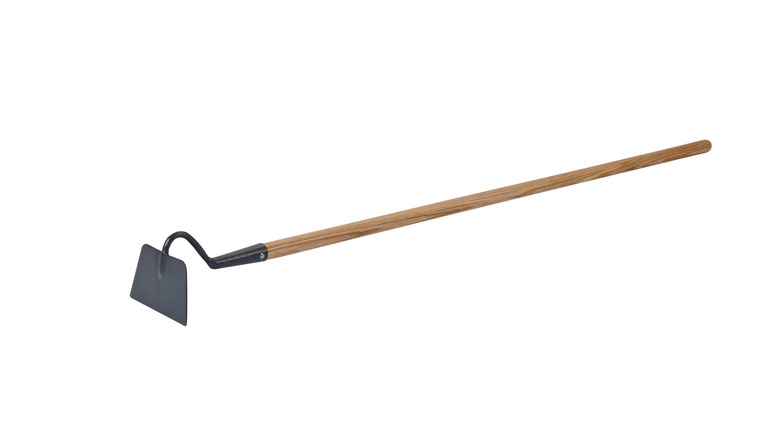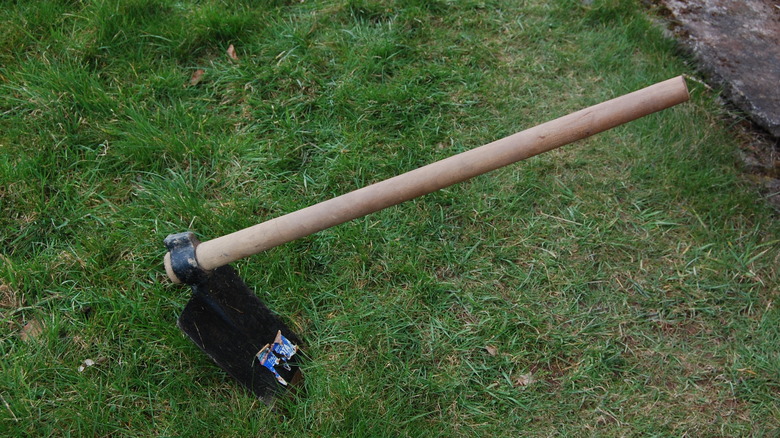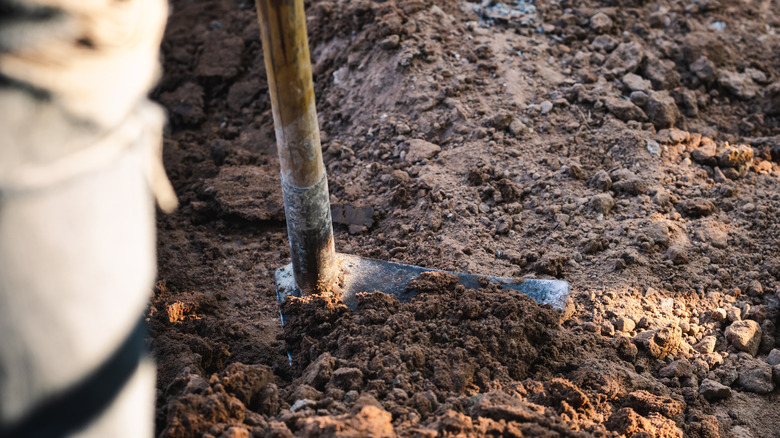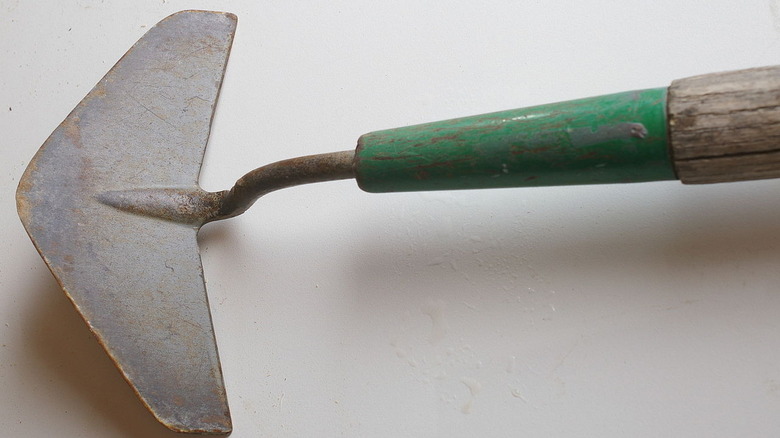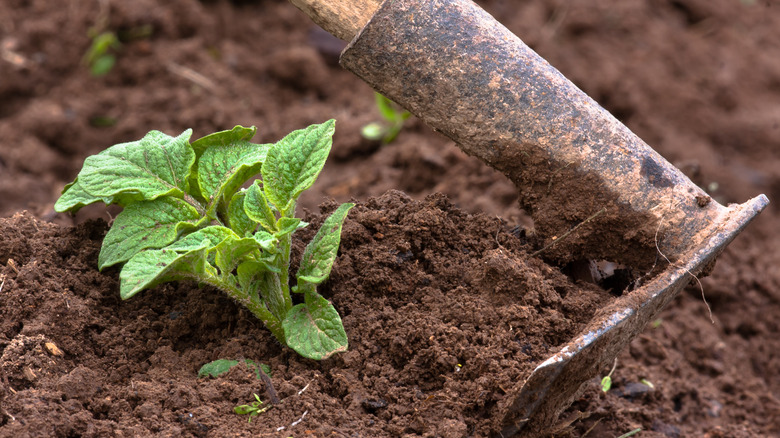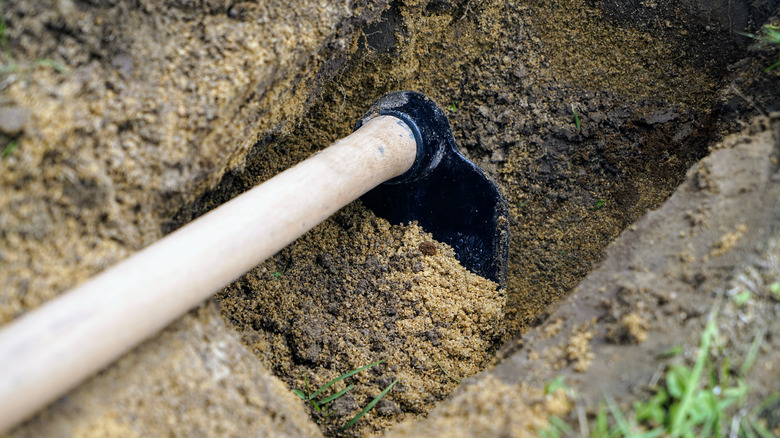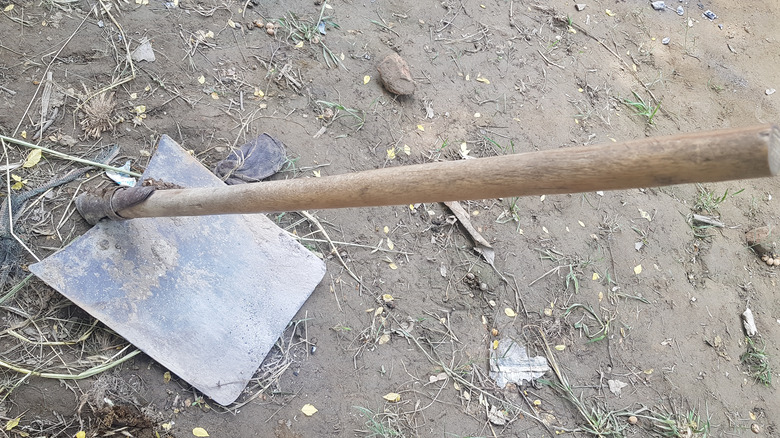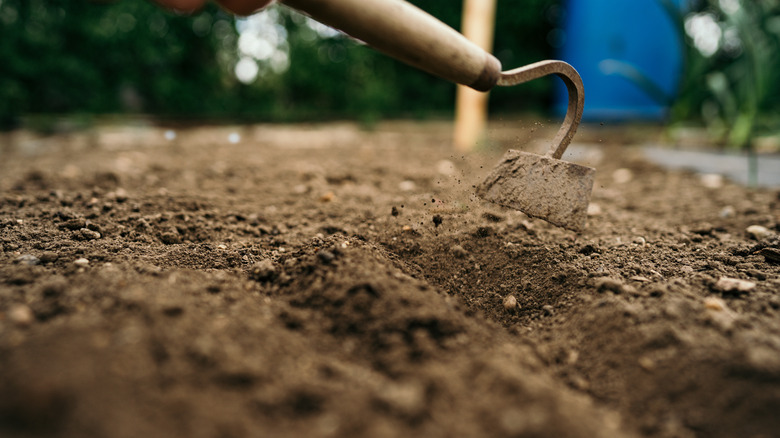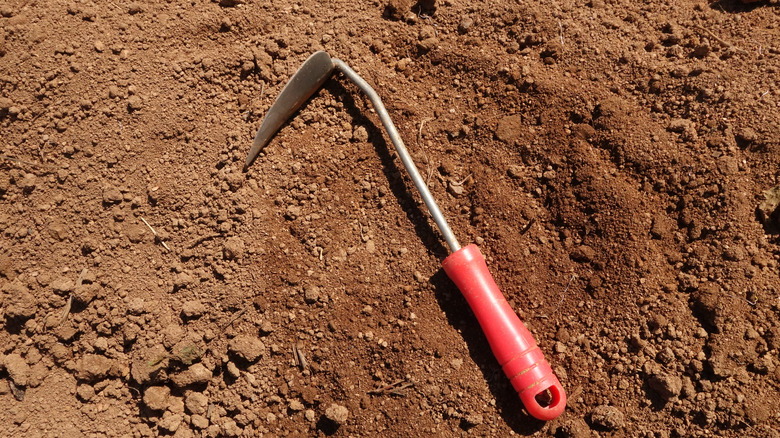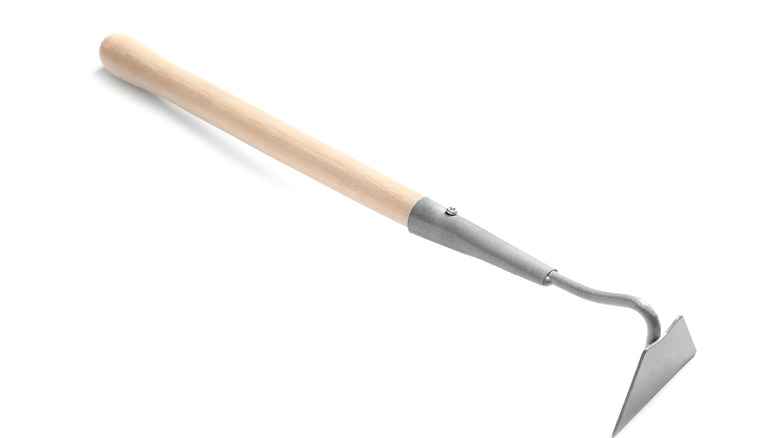15 Types Of Garden Hoes And How They All Differ
We dug into the world of groundskeeping and discovered 50 types of garden hoes. Easy Digging, an authority on digging tools, simplified our research by classifying them into five groups based on "what they are most useful for, the action used to operate the tool, and what soil type they work best in." The categories are as follows: digging hoes, draw hoes, reciprocating hoes, flat hoes, and sweeping hoes.
Even though we cannot cover each variety of hoe, we will discuss the most common to help you make smart purchases in the future. When it comes to garden hoes, there are two things to note: the purpose of the tool and the action which makes them work. Digging hoes, for instance, use a chopping action to penetrate and work the soil. Reciprocating hoes, on the other hand, use a to-and-fro scrubbing motion to remove weeds in medium to soft soils. If you want to choose the right garden hoe every time, continue reading.
1. Dutch hoes
A Dutch hoe, also termed a push hoe, is a type of flat hoe that uses a push and pull movement to clear land or remove weeds from loose or soft soil. Unlike a basic garden hoe, weeding with a Dutch hoe is a much more pleasant experience because you do not have to angle the blade upward and push it back down like splitting wood, per Gardening Know How.
A Dutch hoe is comprised of a long wooden handle and a 90-degree angled blade which faces forward to cut unwanted plants at their roots. See how to use a Dutch hoe.
2. Grub hoes
Grub hoes are part of the most common types of garden hoes. Essentially, they are digging hoes because they use swift, downward motions to dive into the soil at a 45-degree angle to sever root systems or stems. Weed Cut says that a standard grub hoe weighs between two to five pounds and consists of a shaft connected to a heavy-duty blade.
After swinging this garden tool into the soil, you can pull it towards your body to further loosen the roots or lift it high to avoid disturbing the soil. Be sure to always use your grub tool on relatively flat lands or soils devoid of rocks. See how to use a grub hoe.
3. Draw hoes
Draw garden hoes have a handle that sits atop a wide blade. But because they are not meant for making deeper cuts into soil, they feature light hoe-heads. A draw hoe primarily uses a chopping action to break apart clumps of soil from harder ground or loosen weeds to ensure quick removal. However, they can be used to shape soil, make shallow trenches, or build up mounds of soil for cultivation purposes.
Here is a great tip from Strimmer Reviews: Always opt for a draw hoe that has scratch and rust-resistant properties, a carbon steel blade, and a weatherproofed wooden handle equipped with a soft grip sleeve. See how to use a draw hoe.
4. Eye hoes
A common misconception is that an eye hoe and a grub hoe are the same tools. They are not. The former is classified as a draw hoe and the latter, a digging hoe. An eye hoe, otherwise known as scovil hoe, is the oldest, stoutest variety of garden hoes. It is a heavy-duty garden tool, traditionally featuring a smooth, ash wood handle that fits snugly into a tapered collar or hole atop the blade, Red Pig Tools describes.
This garden tool is great for hacking large weeds and grass clumps, as well as scraping through the soil to eliminate small weeds. Eye hoes are one of the most common types of garden hoes. See how to use an eye hoe.
5. Stirrup hoes
Stirrup hoes, categorized as reciprocating hoes, are used for weeding between rows. They have a long wooden handle and a narrow, u-shaped, pivoting blade that cuts and uproots weeds when pushing and pulling the hoe back and forth.
These garden tools are known to minimize soil disturbance because they scrape through the soil at a shallow angle, typically 15 to 2 degrees, allowing you to use them safely near live plants. Stirrup hoes are multipurpose; you can use them to aerate the soil in the dry season and as a rake to gather weeds, Market Gardener Institute assures. See how to use a stirrup hoe.
6. Heart-shaped hoes
Foreseeably, these types of gardening hoes feature a beautiful heart-shaped blade made of carbon steel and long handles that resemble a baseball bat. They are particularly easy on the back muscles because they use a push and pull motion instead of a chopping action. Per Gardeners' World, heart-shaped hoes are sturdy and can be used to break up hard ground at the start of the season or loosen compacted soil caused by erosion.
Its narrow blade head makes it easy to get to all those weeds located in tricky spots and between plants. When using a heart-shaped hoe, ensure that the blade lies flat on the ground. See how to use a heart-shaped hoe.
7. Ridging hoes
This gardening tool is also known as a Warren hoe or drill hoe. Its blade may be triangular or heart-shaped, depending on your preference. Since a ridging hoe is drawn through the soil in long strokes, it is primarily used for loosening, digging, and tilling gardens, or creating long straight furrows for seeding and planting seedlings.
But that is not all, it is also used to remove weeds in tight and hard-to-reach places. As its name implies, it can aid in pulling and piling soil around the base of plants like potatoes to encourage a healthy crop. Per the Independent, ridging hoes make effective vegetable harvesting tools. See how to use a ridging hoe.
8. Field hoes
Field hoes are one of the best types of gardening hoes for eliminating dense, established weeds. They possess heavy-duty blades made of high-grade tempered steel, which penetrate soils at a 45-degree angle. The hoe head has three sharp edges — the base and both sides — giving them superior cutting power.
This, according to Backyard Diggs, makes field hoes the perfect gardening tool for chopping hardened earth, aggressive weeding, breaking up sod, landscaping, and cultivating crops. In most cases, field hoes have a 40- to 60-inch handle made of wood or fiberglass, which locks firmly in place in the eye of the hoe head. See how to use a field hoe.
9. Collinear hoes
Collinear hoes are, in essence, sweeping hoes because the blade is swept forward and backward in short strokes to cut or uproot small weeds. They feature a long handle held fairly upright and a thin, sharp blade that scrapes just under the surface of the soil to remove root systems, Gardening Know How notes.
We like these low-impact weeders because they are capable of removing weeds under and around low-lying crops without destroying them. When using a collinear hoe close to your crops, look straight down at the blade to allow precision. Pro tip: Use this tool in sweeping motion bedside you. See how to use a collinear hoe.
10. Scuffle hoes
What we have here is a scuffle hoe, one of the popular types of gardening hoes. It features a blade that is sharp on both edges and can cut weeds in soil when pushed forward or drawn back, via Weed Cuts. The depth of cut achieved with this tool largely depends on how deeply or lightly you move it through the earth.
You can work a scuffle hoe on the surface of the soil to cut root crowns or angle it ¼ to ½ inch deep to sever the roots systems of a weed. Be sure to sharpen your scuffle hoe regularly to maintain accuracy and optimal performance. See how to use a scuffle hoe.
11. Action hoes
Action hoes are classified as reciprocating hoes since they use a back and forth scrubbing motion to get rid of unwanted plants. They are great for eliminating weeds between rows and around live growing plants. According to Mike's Backyard Nursery, their narrow, stirrup-shaped blade allows you to work close to the desired plants without fear of uprooting them.
Action hoes are known to cut the time for weeding in half without causing strain to the shoulders and back. They also work as a cultivating tool, helping you to prep a bed for planting, and later on, cleaning the rows of weeds during the growing season. See how to use an action hoe.
12. Swan neck hoes
These types of gardening hoes are termed light draw hoes because they have longer and lighter necks, which permit adjustment, unlike standard draw hoes. Once you find a comfortable angle, you will notice how quickly and effortlessly they slide on the ground to cultivate, destroy weeds, or break up soils.
Swan neck hoes, also known as half-moon hoes, have incredibly sharp forged edges to help you pull weeds easily at the soil surface without chopping the soil, via Backyard Digs. In most cases, their design consists of a curved neck, long handle timber or metal shaft, and powder-coated carbon steelhead. See how to use a swan neck hoe.
13. Diamond hoes
This is another type of flat hoe that uses a push and pull motion in loose or soft soils to eliminate weed crowns and root systems. Diamond garden hoes are quite a versatile tool because you can use the sharp edges on all four sides of the diamond-shaped blade to work the soil, per A Nest With A Yard.
The pointed, bottom tip of the hoe head, for instance, is perfect for reaching weed roots below the surface of the soil. The other sharp ends can get close to target live growing plants without causing damage. The blade of this gardening tool is typically 5 and 3/4 inches wide. See how to use a diamond hoe.
14. Swage hoes
Swage hoes, otherwise known as Ploskorez hoes, are native to Russia and are considered one of the most popular types of gardening hoes. They are the most versatile tool on this list, capable of shaping growing plants, mixing up concrete, slashing overgrown weeds, and performing a slew of weeding tasks. They can also be used for soil preparation work, mixing and applying fertilizer and compost into the soil, and planting seeds and seedlings in hard-to-reach places.
As Easy Digging writes, swage hoes are compact, made of stainless steel, and typically are 5 inches long with a 1.5-inch wide blade. See how to use a swage hoe.
15. Trapezoid hoes
According to Objects of Use, trapezoid hoes are perfect for removing mid-sized to established weeds in hard or soft soil using a pulling or scraping action. There are different sizes on the market, each offering cultivators options for various weeding tasks. Trapezoid hoes typically have a replaceable spring blade connected to a curved galvanized steelhead.
The blades are beveled-shaped, promoting precision weeding and facilitating the removal of stubborn weeds via its sharp, pointed corners. Pro tip: Using these gardening tools aggressively could bend their necks. See how to use a Trapezoid Hoe.

